Anterior Ankle Impingement
Updated:
(Also known as Ankle Impingement, Anterior Impingement Syndrome, Anterior Impingement of the Ankle)
What is anterior ankle impingement?
Anterior ankle impingement is a condition characterised by pain at the front of the ankle joint due to compression of bony or soft tissue structures during activities involving maximal ankle dorsiflexion (figure 2).
The ankle joint primarily comprises of the articulation of two bones, the tibia (shin bone) and a small bone which lies directly beneath it called the talus (figure 1). The surface of each bone is lined with cartilage, cushioning the impact of the tibia on the talus during weight bearing activity.
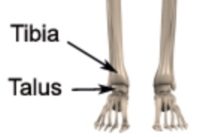
During the movement of ankle dorsiflexion (figure 2) i.e. when the foot and shin move towards each other, the bottom of the shin bone approaches the front of the talus. This places compressive forces on the structures at the front of the ankle joint. If these forces are excessive or beyond what the ankle can withstand, damage and inflammation of these structures may occur. This condition is known as anterior ankle impingement. Occasionally, bony spurs can also form at the front of the ankle joint which may contribute to the problem.
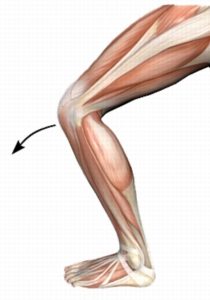
Causes of anterior ankle impingement
Anterior ankle impingement most commonly occurs following an ankle sprain (particularly those involving significant weight bearing forces). The condition may also occur gradually over time due to activities requiring repeated forced dorsiflexion of the ankle (figure 2) usually during weight bearing activity (such as repetitive landing from a jump, deep squatting, running uphills etc.).
Signs and symptoms of anterior ankle impingement
Patients with anterior ankle impingement typically experience pain at the front of the ankle that increases with excessive dorsiflexion or weight bearing activities. Symptoms may also increase after these activities with rest (especially at night or first thing in the morning) and may present as a dull ache or a more acute, sharper pain. Provocative activities may include:
- Walking or running excessively (especially up hills or on uneven surfaces)
- Deep squatting or lunging (especially with the knee moving forwards over the toes)
- Landing from a jump (particularly onto an incline or an uneven surface)
- Performing a calf stretch (particularly with the knee bent)
- Heavy lifting
- Twisting activities
Patients with this condition also often experience pain on firmly touching the front of the ankle joint and in some cases a clicking sensation may be experienced during certain ankle movements. Puffiness or swelling of the ankle joint may also be noticeable in some patients with this condition.
Treatment for anterior ankle impingement

Members Only ContentBecome a PhysioAdvisor Member to gain full access to this exclusive content. For more details see Become a Member. Already a member? Login Now
Contributing factors to the development of anterior ankle impingement
There are several factors which can predispose patients to developing anterior ankle impingement. These need to be assessed and corrected with direction from a physiotherapist. Some of the factors which may contribute to the development of this condition include:
- inadequate rehabilitation following a previous ankle injury
- joint stiffness or swelling
- muscle tightness
- bony anomalies
- poor foot biomechanics (e.g. “flat feet” or high arches)
- poor lower limb biomechanics
- inappropriate training (including technique, footwear or training surfaces)
- excessive training or activity
- inadequate recovery periods from training or activity
- inadequate warm up
- poor core stability
- poor proprioception or balance
Physiotherapy for anterior ankle impingement
Physiotherapy treatment is vital to hasten the healing process and ensure an optimal outcome in all patients with this condition. Treatment may comprise:
- soft tissue massage
- joint mobilisation
- electrotherapy (e.g. ultrasound)
- anti-inflammatory advice
- stretches
- dry needling
- Achilles taping, ankle taping or arch support taping
- ankle bracing
- the use of crutches
- the use of heel wedges
- ice or heat treatment
- exercises to improve flexibility, strength and balance
- education
- activity modification advice
- biomechanical correction
- a gradual return to activity program
Other intervention for anterior ankle impingement
Despite appropriate physiotherapy management, some patients with this condition do not improve and may require other intervention to ensure an optimal outcome. The treating physiotherapist or doctor can advise on the best course of management when this is the case. This may include further investigation such as an X-ray, ultrasound, MRI, CT scan or bone scan, extended periods of rest, pharmaceutical intervention, corticosteroid injection, referral to a podiatrist for footwear advice and possible orthotics, or referral to appropriate medical authorities who can advise on any intervention that may be appropriate to improve the condition. For those patients with prominent bony spurs or significant soft tissue impingement, surgical intervention (such as an ankle arthroscopy) may be indicated to remove the bony spur or damaged tissue.
Exercises for anterior ankle impingement
The following exercises are commonly prescribed to patients with this condition. You should discuss the suitability of these exercises with your physiotherapist prior to beginning them. Generally, they should be performed 2 – 3 times daily and only provided they do not cause or increase symptoms.
Your physiotherapist can advise when it is appropriate to begin the initial exercises and eventually progress to the intermediate, advanced and other exercises. As a general rule, addition of exercises or progression to more advanced exercises should take place provided there is no increase in symptoms.
Initial Exercises
Foot and Ankle Up and Down
Move your foot and ankle up and down as far as you can go without pain and provided you feel no more than a mild to moderate stretch (figure 3). Repeat 10 – 20 times provided the exercise is pain free.
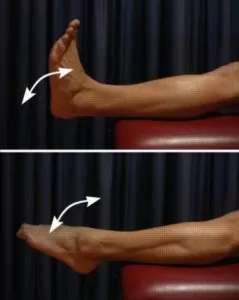
Foot and Ankle In and Out
Move your foot and ankle in and out as far as you can go without pain and provided you feel no more than a mild to moderate stretch (Figure 4). Repeat 10 – 20 times provided the exercise is pain free.
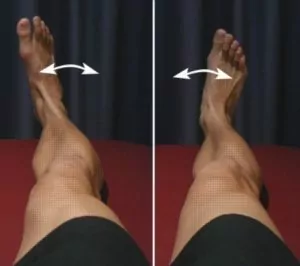
Foot and Ankle Circles
Move your foot and ankle in a circle as large as you can go without pain and provided you feel no more than a mild to moderate stretch (figure 5). Repeat 10 – 20 times in each direction provided the exercise is pain free.
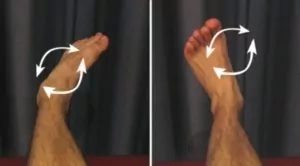
Intermediate Exercises

Members Only ContentBecome a PhysioAdvisor Member to gain full access to this exclusive content. For more details see Become a Member. Already a member? Login Now
Advanced Exercises

Members Only ContentBecome a PhysioAdvisor Member to gain full access to this exclusive content. For more details see Become a Member. Already a member? Login Now
Other Exercises

Members Only ContentBecome a PhysioAdvisor Member to gain full access to this exclusive content. For more details see Become a Member. Already a member? Login Now
Rehabilitation Protocol for anterior ankle impingement

Members Only ContentBecome a PhysioAdvisor Member to gain full access to this exclusive content. For more details see Become a Member. Already a member? Login Now
 Physiotherapy products for anterior ankle impingement
Physiotherapy products for anterior ankle impingement
Some of the most commonly recommended products by physiotherapist for patients with this condition include:
-
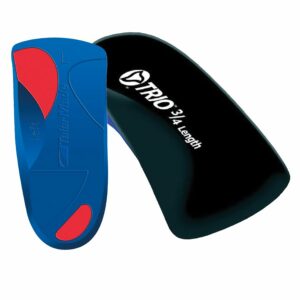 Talar Made TRIO Orthotics (3/4 length)
Talar Made TRIO Orthotics (3/4 length) -
 Comffit Elevators – Moulded Heel Lifts (Pack of 3 Pairs)
Comffit Elevators – Moulded Heel Lifts (Pack of 3 Pairs) -
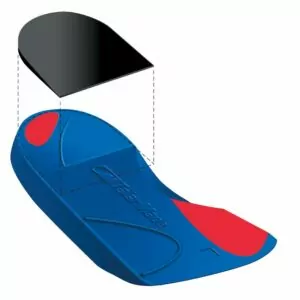 Heel Lifts (Elevators – Talar Made) (Pack of 5 Pairs)
Heel Lifts (Elevators – Talar Made) (Pack of 5 Pairs) -
 Forearm Crutches Adjustable – Standard Grip
Forearm Crutches Adjustable – Standard Grip -
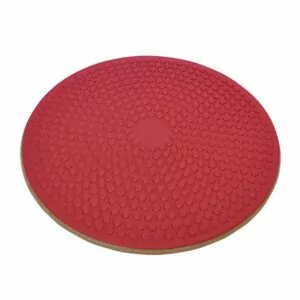 AllCare Wobble Board (Red – ACWOBRD)
AllCare Wobble Board (Red – ACWOBRD) -
 AllCare Band
AllCare Band -
 Premium Strapping Tape 38mm (Victor)
Premium Strapping Tape 38mm (Victor) -
 AllCare Spikey Massage Ball
AllCare Spikey Massage Ball -
 Fixomull Stretch 5cm x 10m
Fixomull Stretch 5cm x 10m -
 AllCare Instant Cold Pack (15 x 25cm)
AllCare Instant Cold Pack (15 x 25cm) -
 AllCare Foam Roller Round
AllCare Foam Roller Round
To purchase physiotherapy products for anterior ankle impingement click on one of the above links or visit the PhysioAdvisor Shop.
 More Exercises
More Exercises
- Ankle Stretches.
- Ankle Strengthening Exercises.
- Balance Exercises.
- Leg Stretches.
- Leg Strengthening Exercises.
 More Information
More Information
- Learn How to use Crutches.
- View detailed information on when to use Ice or Heat.
- Read about initial injury management and the R.I.C.E. Regime.
- View Do I Need Orthotics.
- Learn key tips on Choosing a Shoe.
- View tips on Returning to Sport.
- View detailed information on Returning to Running.
- Learn about commonly used taping for anterior ankle impingement – Achilles Taping
- Explore our Ankle Diagnosis Guide.
 Find a Physio for Anterior Ankle Impingement
Find a Physio for Anterior Ankle Impingement
Find a physiotherapist in your local area who can treat this condition.
Become a PhysioAdvisor Member
-
 Individual Membership (12 Months)$59.95 for 1 year
Individual Membership (12 Months)$59.95 for 1 year -
 Individual Membership (3 Months)$39.95 for 3 months
Individual Membership (3 Months)$39.95 for 3 months -
 Individual Membership (Yearly)$49.95 / year
Individual Membership (Yearly)$49.95 / year -
 Individual Membership (Monthly)$15.95 / month
Individual Membership (Monthly)$15.95 / month

Link to this Page
If you would like to link to this article on your website, simply copy the code below and add it to your page:
<a href="https://physioadvisor.com.au/injuries/ankle/anterior-ankle-impingement”>Anterior Ankle Impingement – PhysioAdvisor.com</a><br/>PhysioAdvisor offers detailed physiotherapy information on Anterior Ankle Impingement including causes, signs & symptoms, diagnosis, treatment, prognosis, exercises, rehabilitation guide, physiotherapy products and more...
Return to the top of Anterior Ankle Impingement.
